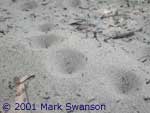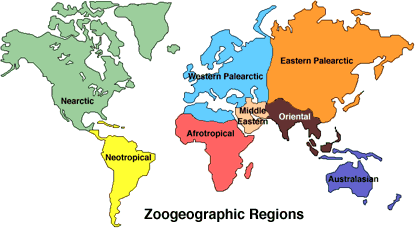Habitat
 Figure 1. Cluster of pits made by pit-digging antlion larvae. Photo taken in Indiana (USA). © 2001 Mark Swanson |
Antlions are typically most active during late spring and summer, although they may remain active during winter in warmer climates. Antlions have been observed in Yosemite National Park (USA) even during January, when temperatures dip below 0° C (32° F).
Distribution
The approximately 2,000 species of antlions are distributed throughout the world, primarily in the warmer regions (Grzimek 1979, 227). In North America, the greatest number of genera and species are found in the southwestern states of the U.S. (Arnett 1985, 260). One of the most common North American species is Myrmeleon obsoletus. The main European species are Myrmeleon formicarius and Euroleon nostras (Grzimek 1979, 224).
Zoogeographic Locator
Zoogeography is the study of the relationship between specific animal species and the regions in which they live. There are eight different zoogeographic regions in the world. Click any region in the "Zoogeographic Locator" below (Figure 2) for information about the antlions that live there.|
|
Figure 2. Zoogeographic Regions. Note: Regional names and boundaries vary in the scientific literature; this map is a composite representation.

